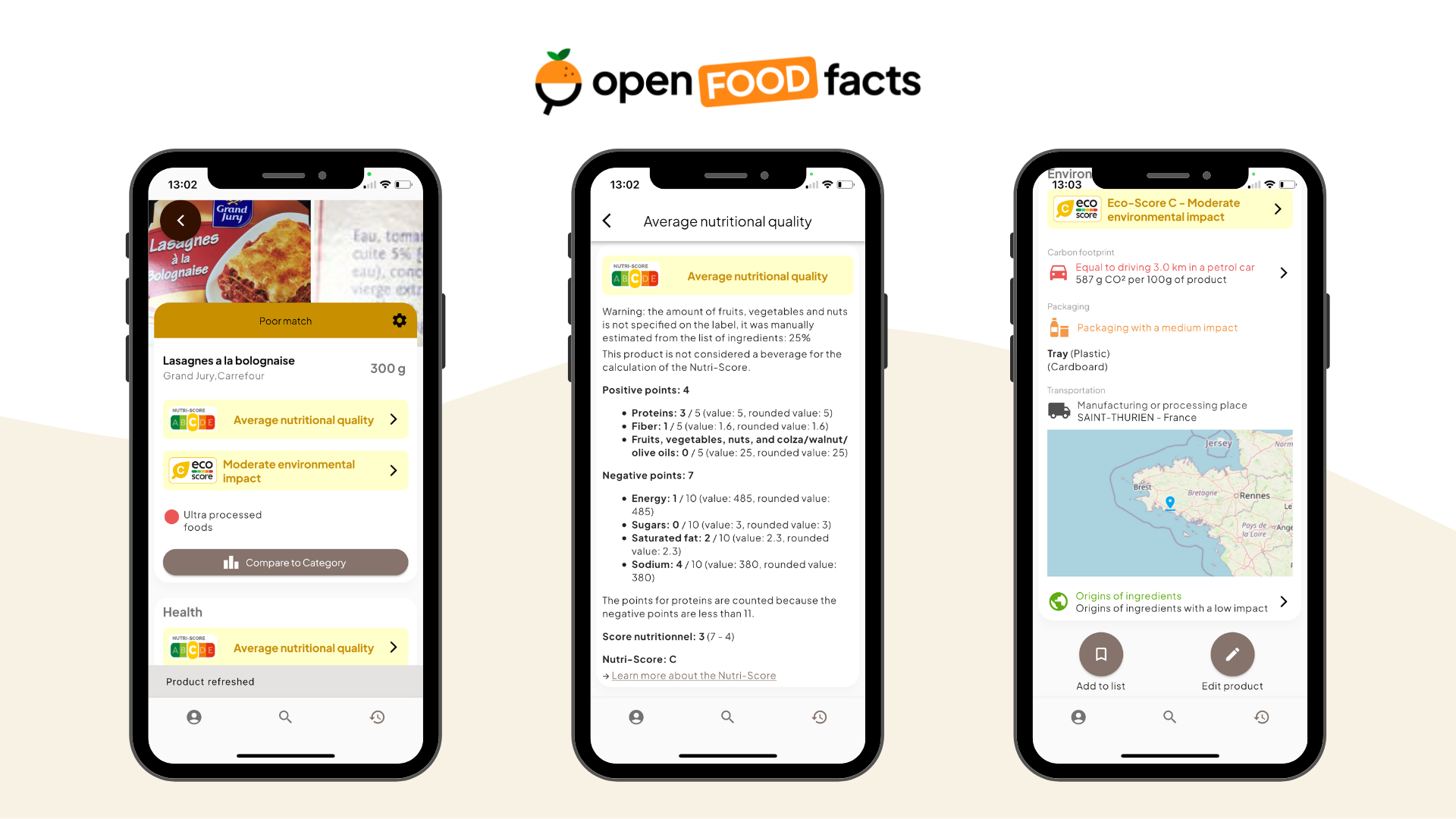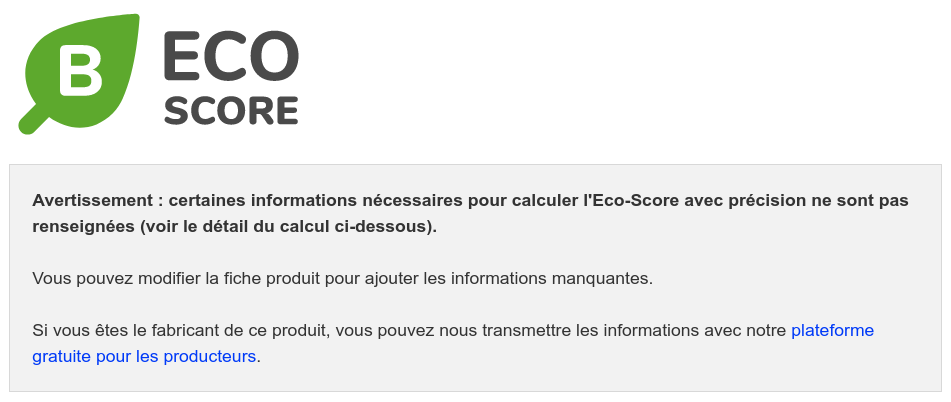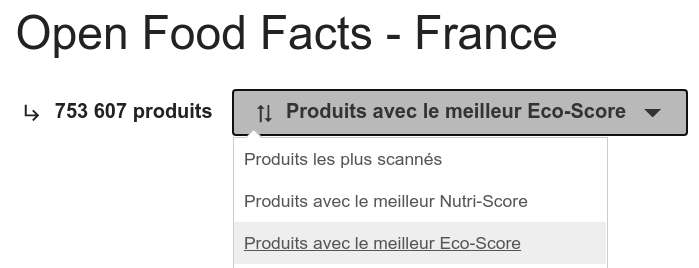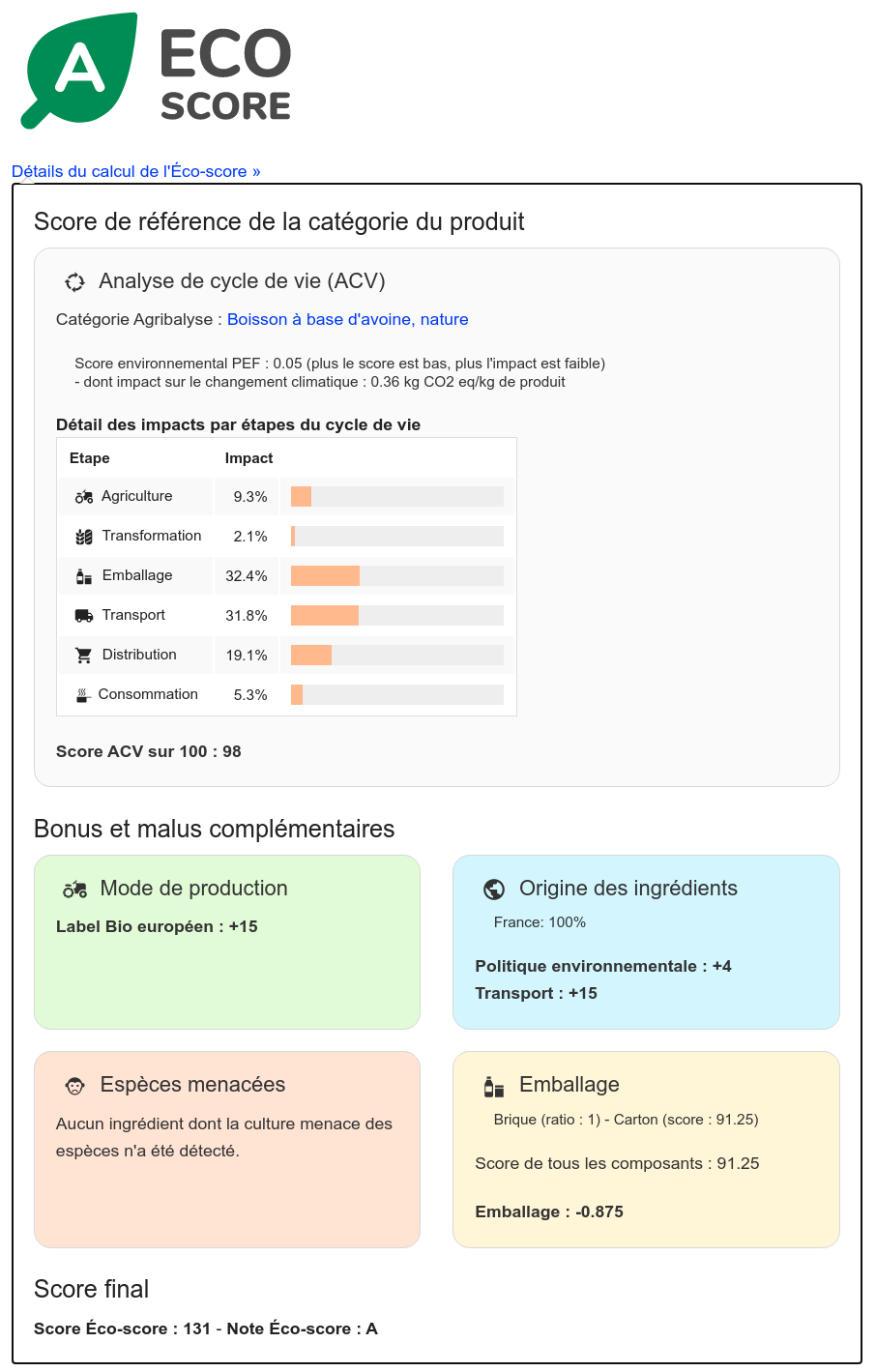„Eco-Score“: maisto produktų poveikis aplinkai

„Eco-Score“ yra aplinkosaugos įvertinimas (ecoscore) nuo A iki E, leidžiantis lengvai palyginti maisto produktų daromą poveikį aplinkai.
- Kodėl reikalingas aplinkosaugos įvertinimas?
- Kas yra „Eco-Score“?
- How is the Eco-Score calculated?
- The benchmark score: life cycle analysis (LCA) with data from the Agribalyse database
- Bonuses and penalties to refine the grading of each product
- An increased need for transparency to better measure and reduce environmental impacts
- How to see the Eco-Score for food products?
- Scan products with the Open Food Facts app
- Compare the Eco-Score of products on the Open Food Facts site
- How the Eco-Score can encourage the improvement of products and the reduction of their environmental impacts
- How can we find out more and how can we help us develop the Eco-Score?
- Acknowledgments
- References
Kodėl reikalingas aplinkosaugos įvertinimas?
Vis daugiau vartotojų yra susirūpinę dėl maisto poveikio ne tik savo, bet ir mūsų planetos sveikatai. „Nutri-Score“ dėka dabar labai lengva atsižvelgti į produktų maistinę kokybę perkant, tačiau labai sunku, o gal ir neįmanoma palyginti jų ekologinį pėdsaką.
Būtina skubiai suteikti vartotojams aiškią informaciją apie šį ekologinį pėdsaką, kad jie galėtų lengvai ir greitai palyginti kelis produktus. Tai leidžia pasiekti „Eco-Score“ aplinkosaugos įvertinimas.
„Eco-Score“ - tvaresnio maisto priemonė
„Eco-Score“ padeda vartotojams, norintiems pereiti prie tvaresnės mitybos, skatinant:
- Valgyti mažiau, bet kokybiškesnės mėsos
- Vartoti ekologiškus produktus ir produktus su kokybės ženklinimais
- Rinktis vietinę ir sezoninę produkciją su mažiau įpakavimo
- Riboti produktus, kuriuose yra probleminių ingredientų (nykstanti žuvis, netvarus palmių aliejus)
Kas yra „Eco-Score“?
„Eco-Score“ sukurtas pagal modelį, panašų į „Nutri-Score“: tai nuo A iki E įvertinimas, kuriame apibendrinami 15 poveikių aplinkai. „Eco-Score“ balas vaizduojamas spalvotu lapo formos logotipu su raide nuo A (labai mažas poveikis) iki E (labai didelis poveikis).

„Eco-Score“ yra palaikomas daug skirtingų organizacijų, pasiryžusių gerinti mitybą.

How is the Eco-Score calculated?
The benchmark score: life cycle analysis (LCA) with data from the Agribalyse database
For each product category, a benchmark score is established using data from the Agribalyse environmental database designed by ADEME and INRAE. These data correspond to the life cycle analysis (LCA) of the products.
Life cycle assessment (LCA)
Life cycle analysis is a standardized assessment method for carrying out a multi-stage environmental assessment and multi-criteria:
- 6 production steps: agriculture, processing, packaging, transportation, distribution and consumption
- 14 environmental impact indicators: climate change/carbon footprint, ozone layer depletion, ionizing radiation, land, water, and energy use; pollution of air and marine and fresh water (particles, acidification, eutrophication); and depletion of resources.
Bonuses and penalties to refine the grading of each product
In order to take into account certain impacts on the environment which are not covered well by the life cycle analysis (such as biodiversity) and the specificities of each product within the same category, the score of reference is modulated with bonuses and penalties:
Mode of production
A bonus is awarded to products that have an official label, a label or a certification that guarantees environmental benefits (organic, fair trade, HVE, Label Rouge, Bleu Blanc Cœur, MSC/ASC).
Sudedamųjų dalių kilmė
A bonus is awarded based on the origin of the ingredients. This bonus takes into account the impact on transportation and also the environmental policy of each producer's country.Endangered species
A penalty is given to products that contain ingredients that have significant negative impacts on biodiversity and ecosystems, such as palm oil, the production of which is responsible for massive deforestation.
Pakuotė
A penalty is calculated to take into account the circularity of packaging (use of recycled raw material and recyclability) and overpacking.
An increased need for transparency to better measure and reduce environmental impacts
To accurately calculate the Eco-Score, it is necessary to have information which is not necessarily specified on the packaging (such as the origin and the exact percentage of each ingredient) or which is rarely available in usable form (such as a list of all the components of the packaging with the precise types of plastics used).
Average values are used when this information is not yet available, but we are now calling on everyone to help us collect this information which will be very useful for the Eco-Score but also for many other uses.
- Manufacturers can send us their information directly through our free platform for producers.
- All citizens can help us gather and structure the information that is present on products or that can be deduced from them, such as information on packaging: Mission Emballages: a large-scale collaborative inventory of packaging for all food products (in French)
How to see the Eco-Score for food products?
Scan products with the Open Food Facts app
The Open Food Facts app allows you to quickly get the Eco-Score of products: all you have to do is scan their barcode. If you have already installed the Open Food Facts app, please update it to get the new version!

The Eco-Score is, or will soon be, available in the apps of the launching partners. And Open Food Facts is a Wikipedia of foods that anyone can reuse freely and for free. The more than 100 applications that use the OFF database will also be able to display the calculated Eco-Score.
Compare the Eco-Score of products on the Open Food Facts site
The Open Food Facts website allows everyone to see and compare the Eco-Score of more than 750,000 food products sold in France. The results of each search show the nutritional quality with the Nutri-Score, ultra-processed foods with NOVA, and the environmental impact with the Eco-Score. The Eco-Score will be rolled out to other countries as soon as an applicable Eco-Score calculation is available.

The Eco-Score of prepared meals on Open Food Facts
Classify and explore products by Eco-Score on Open Food Facts
And see at a glance the Eco-Score of the products of a category or a brand.

The Eco-Score of prepared meals. Click to see the products for each grade on Open Food Facts.
Obtain the details of the Eco-Score calculation for all products
For each product, a link allows you to display the complete details of the Eco-Score score calculation.
And if information is missing, anyone can add it: the manufacturer of the product but also all citizens committed to the climate, environmental protection and transparency.

How the Eco-Score can encourage the improvement of products and the reduction of their environmental impacts
The Eco-Score has two levers of action:
- With the Eco-Score, consumers can make a more informed choice by taking into account the environmental impact of products as a criterion of choice.
- The Eco-Score also encourages manufacturers to improve their products so that they achieve a higher Eco-Score rating.
Manufacturers improving the Eco-Score of their products is the ultimate goal, as it will benefit all consumers.
The energy rating of household appliances has thus profoundly transformed the market (try to find a fridge rated E, or even D or C!). And the democratization of Nutri-Score has also encouraged many manufacturers to improve the nutritional quality of their products to obtain a better rating (to the point that some French manufacturers even brag about it on bus stops, such as Brossard for its Savane cake).
To encourage product improvements, our platform for producers automatically analyzes data provided by manufacturers to identify avenues for improvement. The platform thus identifies all the products that would obtain a better Nutri-Score score with a slight change in composition (a reduction in salt of 5% for example).
Soon, the platform will make it possible to suggest ways to reduce the ecological impact and obtain a better Eco-Score (for example by using a more recyclable plastic for packaging, or by replacing palm oil with another oil).
How can we find out more and how can we help us develop the Eco-Score?
Everyone is welcome to help us create more transparency, educate consumers, and encourage product improvement through Eco-Score.
The Eco-Score is still young and can certainly be improved. Given the climate and environmental emergency, however, it seems important to us to make it available now.
By working together, we will be able to gradually improve the Eco-Score, refine its formula, and gather the data necessary for its calculation.
Your feedback, observations and suggestions will therefore be very valuable.
- If you are a journalist and want to know more, you can contact Pierre Slamich - pierre@openfoodfacts.org- +33 6 02 13 14 57
- If you are a manufacturer, you can send us information about your products with our free platform for producers, and get the detailed Eco-Score calculation for all your products. For any questions: producers@openfoodfacts.org
- If you are a citizen, you can install the Open Food Facts app, create an account on the Open Food Facts website, join our community of engaged citizens and our Slack discussion space. For any questions: contact@openfoodfacts.org
Open Food Facts is a collaborative project supported by tens of thousands of volunteers
and managed by a non-profit association with 3 employees.
Jūs galite mums padėti prisidėdami prie „Open Food Facts“ 2023 m. biudžeto
ir toliau vystydami „Eco-Score“ ir daug kitų projektų, kad pagerėtų kiekvieno mityba. Thank you! ❤️
Acknowledgments
Thanks to the teams of ADEME, l'INRAE and all Agribalyse partners for the constitution of this unique environmental database and its publication in open data.
Thank you to all those involved in creating a common Eco-Score.
Thanks to the organizers and volunteers of Data For Good who greatly improved the artificial intelligence algorithms of Open Food Facts.
Thanks to the AFNIC Foundation for its support for the implementation of the Eco-Score in Open Food Facts.
Thanks to Santé publique France (Public Health France) for its crucial support for the development of the platform for producers.
And thank you to all the participants in the Open Food Facts project who for more than 8 years have been promoting food transparency to improve everyone's diet!
References
- Announcement of the launch of the Eco-Score on the Open Food Facts blog
- Open Food Facts App for iPhone on the App Store
- Open Food Facts App for Android on the Play Store
- The distribution of Eco-Score scores for products on the Open Food Facts site
- Detailed documentation of the methodology and formula for calculating the Eco-Score. (in French)
- Agribalyse environmental base of ADEME and INRAE (in French)


